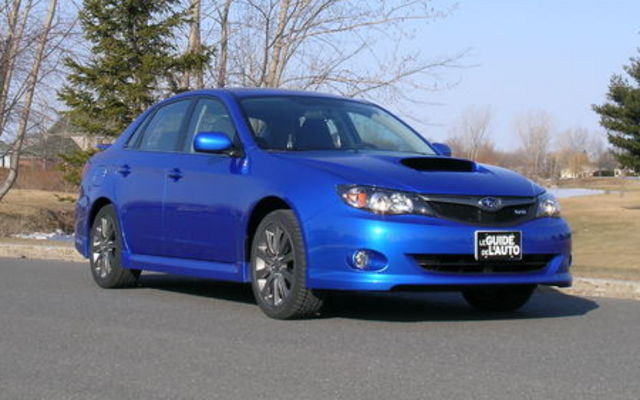Subaru WRX 265 2009: Stuck in the middle!

At Subaru, the Impreza WRX plays the role of a sports car, attracting a younger clientele to the showrooms. There have been two versions of the WRX available for several years now, the base model and the brutish WRX STi. While the first one, at about $35,000, already commanded a hefty price, the STi was even less accessible due to its $50,000ish asking price. These prices didn’t do much to help the cause of these two models that were basically targetted at a young and less affluent clientele.
While the third generation Impreza has been available for a year, this year’s big news is the addition of the WRX 265, a model that is somewhere between the regular WRX and the STi. The name 265 comes simply from the 265 horses that power its turbocharged engine. In order to balance the product line, the manufacturer took the opportunity to remove some of the features from WRX base model, which both lowers its price and makes the WRX line more diverse and reflective of the needs of a broader clientele. Basically, the WRX is now more affordable!
And that’s just what the doctor ordered to help Subaru better compete with Mitsubishi, its main rival in the category. The Mitsubishi Lancer is offered in several different versions, including the regular version, the Ralliart and the Evolution. The rivalry between these two companies continues to feed discussions between enthusiasts and inspire a lot of print articles.
Sedan or wagon?
All of the WRX models are available in the four-door sedan or five-door hatchback versions, with the exception of the STi, which comes only in the five-door configuration. It’s a question of personal preference, but I must admit that I’m a little fonder of the wagon, which is also more practical. Furthermore, this configuration seems to appeal to buyers. The nice thing about Subaru is that regardless of the model you choose, you will get the widely appreciated all-wheel drive.
Under the hood, the WRX comes standard with a turbocharged 2.5-litre, 224-hp four-cylinder paired with a five-speed manual transmission. It’s a sports car that remains agile even though it’s a little more subdued than the old model, mainly because the new generation is bigger and heavier, but also because its settings are oriented a little more toward comfort than toward extreme sportiness. However, with a price that is slightly higher than $30,000, it’s a good deal and it appears that more than a few clients like its more civilized side.
Subaru DNA
As for the WRX 265, it features the same mechanical components, but its updated engine, which includes the addition of a higher performance turbo, enjoys a small boost in power. The WRX’s much more dynamic ride is courtesy of its 41 extra horses and the 18 more pounds per foot of torque which returns the car to a place of distinction. The engineers have also made the suspension springs more firm by borrowing some of the STi’s components, notably its larger stabilizer bars. This edition will certainly feature increased power, but it’s the overall increased dynamism of its settings that also make it more attractive, or at least improve its performance. There’s a nice new look on the outside too, which helps distinguish it from the regular WRX and brings it closer to the STi. Basically, in my opinion, this is the version that offers the best compromise for the price.
The king of the product line is the WRX STi that will also benefit from a pretty significant reduction in price this year.
The most powerful of the WRX models has a 2.5-litre four-cylinder flat engine featuring 305 hp at 6,000 rpm for a torque of 290 lbs-ft at 4,000 rpm. This power is transmitted to the four wheels through a six-speed manual transmission, the only one offered. The STi uses full-time all-wheel drive including a helical-type limited-slip front differential and a torque-responsive Torsen limited-slip rear differential. Offering first-rate performances regardless of the road conditions, the all-wheel drive distributes the torque to the four wheels in the optimal way, maximizing performance in turns and under various other conditions. You can select different modes to modify the settings of the differential using a control placed on the console. This new generation says good-bye to the small control with which you could squirt water on the intercooler. Subaru justifies this loss by adding a larger, thereby more efficient intercooler.
On board, the WRX favours simplicity and sportiness over luxury and comfort. The seats offer good support and remain relatively comfortable for longer rides, especially compared to the seats in the Mitsubishi Lancer Evolution and Ralliart, which prove to be more extreme. However, the advantage goes to Mitsubishi where the audio system is concerned. I must admit that the sound system is one area where Subaru still lags behind, not so much for its features as for the sound quality that leaves a lot to be desired. As for the rest, the trim is meticulous and the materials demonstrate good workmanship.
With the arrival of the WRX 265 and the complete reworking of the product line, you have to admit that Subaru did a great job. Enthusiasts will be attracted by the more affordable models, to the great displeasure of those who bought a WRX last year, while this new product line will be better able to compete against the competition.








